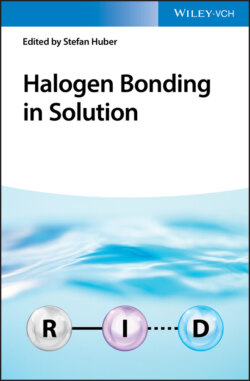Читать книгу Halogen Bonding in Solution - Группа авторов - Страница 30
1.4.5 Charge Transfer
ОглавлениеCharge transfer has long been associated with halogen bonding, and Mulliken's investigations of I2 and organics containing O, S, or N heteroatoms are prime examples [42]. More recently, Palusiak utilized the Kohn–Sham molecular orbital (MO) theory to describe the interaction [148]. Halogen bonds and hydrogen bonds can have significant covalent character due to charge transfer from a guest to the antibonding σ* orbital (LUMO) of the R–X or R–H species [149] (Figure 1.15). The lower‐energy σ* orbital and higher‐energy σ orbital in this halogen bonding example allow for increased orbital mixing (σ orbital mixing shown for R–X donor in Figure 1.15b). These charge‐transfer adducts often result in lengthening of the RX or RH bond, which was highlighted in an early theoretical study of halogen bonding complexes between dihalogens (including interhalogens) and Lewis bases [150]. Here, elongation of the halogen–halogen bond is largest in the strongest complexes, up to 0.065 Å in the FBr⋯NH3 complexes. The study also demonstrated that the most polarizable halogens, and the interhalogens (FBr, FCl, etc.) with the biggest dipole, resulted in the largest interaction energies. Other studies have revealed that charge transfer can be a significant factor in organic halogen bond systems as well. One example evaluated complexes of bromocarbons (e.g. CBr3F, CBr3NO2, CBr3COCBr3, CBr3CONH2, Br3CCN) with anions (Br–, N3–, NCO–, and NCS–) [151,152]. In these reports, increasing charge transfer was linearly correlated with elongation of the CBr bond length. Therefore, as the interaction strength with the Lewis base increases, the CBr bond lengthens, suggesting that the donation of electrons to the antibonding σ* from the p‐orbital of the Lewis base results in a weakening of the CBr bond. These conclusions are further supported by MO theory where charge‐transfer effects are the leading component for organohalogen halogen bond formation in H3CX⋯O<span class="dbond"></span>CH2 and F3CX⋯O<span class="dbond"></span>CH2 (X = Cl, Br, I) models [148].
Figure 1.15 Simplified orbital‐interaction diagrams for (a) hydrogen‐bonded complexes DH⋯A− and (b) halogen‐bonded complexes DX⋯A− as they emerge from quantitative Kohn–Sham MO analyses.
Source: From Wolters and Bickelhaupt [149]. © 2012 John Wiley & Sons.
